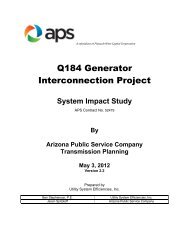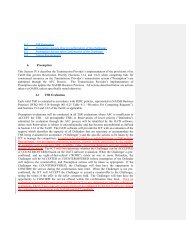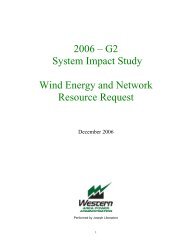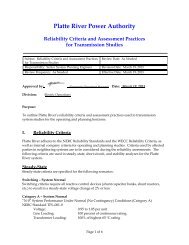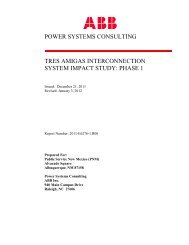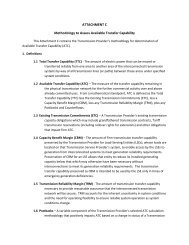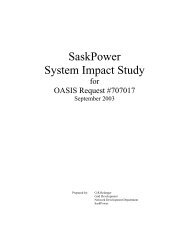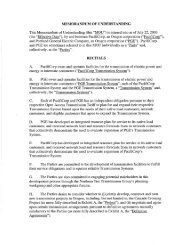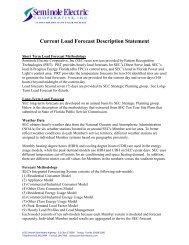SASKPOWER OPEN ACCESS TRANSMISSION TARIFF
SASKPOWER OPEN ACCESS TRANSMISSION TARIFF
SASKPOWER OPEN ACCESS TRANSMISSION TARIFF
Create successful ePaper yourself
Turn your PDF publications into a flip-book with our unique Google optimized e-Paper software.
<strong>SASKPOWER</strong> <strong>OPEN</strong> <strong>ACCESS</strong> <strong>TRANSMISSION</strong> <strong>TARIFF</strong>Under commercial use of an interface, the ATC at a particular point in time can be defined as:ATC = TTC – (TRM C )TRM – ETC – RES – SCHSaskPower’s software uses this equation to calculate the posted ATC for the interface.The two additional terms RES and SCH represent the ATC that has been, up to the point in timebeing considered, sold to a Transmission Customer(s). RES represents the sum of theunscheduled reservations on the interface and SCH represents the sum of the actual scheduledflow across the interface.Determination of TTCSaskPower determines the TTC of an interface based on the capability of the interface facilitiesand the first contingency transmission capability of the SaskPower system. To establish TTC forthe interfaces, the transfer level is increased in steps. At each step, the system is studied todetermine if the system meets the defined performance criteria for the critical contingenciesdefined. The maximum level of transfer, considering most likely load levels and probablegeneration patterns, becomes the TTC for the interface. The TTC for a particular interface isdetermined without simultaneous transfer on other interfaces.The TTC values are derived for power flow in both directions through the interfaces. The studiesare done in coordination with the respective interconnected Transmission Providers and facilityowners.Determination of TRMTRM represents a margin that is applied to account for uncertainties and variations in systemconditions and to allow for operating flexibility. The major components that are considered in thedetermination of TRM include:Probable variations in domestic load levels. SaskPower produces a high and low systempeak load forecast that represents an 80% confidence interval for load growth. These loadforecasts are used to account for load level and load distribution variations.Probable variation in SaskPower generation dispatch which is dependent on hydroconditions, fuel prices, and other applicable conditions.Simultaneous transfers on other interfaces. Currently, there is an interdependencybetween the Saskatchewan-Manitoba and the Saskatchewan-North Dakota interfaces.Parallel path flows. Parallel path flows, due to schedules, are not considered because allSaskPower interfaces are either directly or indirectly controlled.Interface control system deadbands.Page | 112




